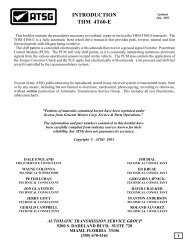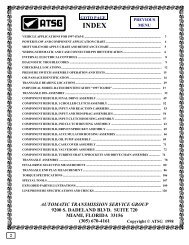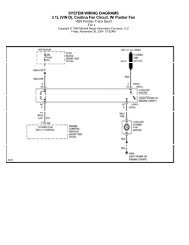Controls
Controls
Controls
Create successful ePaper yourself
Turn your PDF publications into a flip-book with our unique Google optimized e-Paper software.
Your Driving and the Road<br />
Driving on Snow or Ice<br />
Most of the time, those places where your<br />
tires meet the road probably have good<br />
traction.<br />
However, if there is snow or ice between<br />
your tires and the road, you can have a<br />
very slippery situation. You’ll have a lot<br />
less traction or “grip” and will need to be<br />
very careful.<br />
What’s the worst time for this? “Wet ice.”<br />
Very cold snow or ice can be slick and<br />
hard to drive on. But wet ice can be even<br />
more trouble because it may offer the<br />
least traction of all. You can get “wet ice”<br />
when it’s about freezing (32°F; OOC) and<br />
freezing rain begins to fall. Try to avoid<br />
lriving on wet ice until salt and sand<br />
:rews can get there.<br />
Nhatever the condition -- smooth ice,<br />
lacked, blowing or loose snow -- drive<br />
vith caution.<br />
f you have the traction control system,<br />
Leep the system on. It will improve your<br />
tbility to accelerate when driving on a<br />
ilippery road. Even though your vehicle<br />
las a traction control system, you’ll want<br />
o slow down and adjust your driving to<br />
.he road conditions. See “Traction Control<br />
system” in the Index.<br />
[f you don’t have the traction control<br />
Gystem, accelerate gently. Try not to break<br />
:he fragile traction. If you accelerate too<br />
Fast, the drive wheels will spin and polish<br />
:he surface under the tires even more.<br />
Your anti-lock brakes improve your<br />
2bility to make a hard stop on a slippery<br />
road. Even though you have an anti-lock<br />
braking system, you’ll want to begin<br />
stopping sooner than you would on dry<br />
pavement. See “Anti-Lock” in the Index.<br />
Allow greater following distance on<br />
any slippery road.<br />
Watch for slippery spots. The road<br />
might be fine until you hit a spot that’s<br />
covered with ice. On an otherwise<br />
clear road, ice patches may appear in<br />
shaded areas where the sun can’t<br />
reach: around clumps of trees, behind<br />
buildings, or under bridges.<br />
Sometimes the surface of a curve or<br />
an overpass may remain icy when the<br />
surrounding roads are clear. If you see<br />
a patch of ice ahead of you, brake<br />
before you are on it. Try not to brake<br />
while you’re actually on the ice, and<br />
avoid sudden steering maneuvers.<br />
. 166








